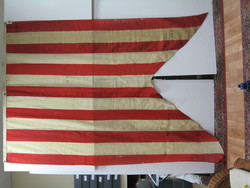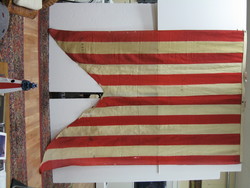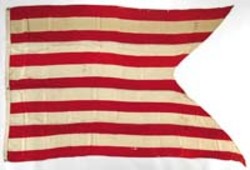

Obverse

Reverse

Catalog Image

Catalog Image - 2

































































Preble scan Plate PVII
U.S. Navy Commodores Broad Pennant 1869-1876.
Sub-collection: Decatur Collection of Military & Naval Service - Spanning 100 yearsU.S. Navy Commodores Broad Pennant - Stephen Decatur, 1869-1876.
This is an extremely rare, dyed, wool, Commodores Broad Pennant of the type used by the US Navy for a brief period from 1 January 1870 to 6 January 1876. During this period, for reasons that still remain unclear, the United states Navy abandoned its system of blue flags bearing the appropriate numbers of stars for an admiral's grade, replacing it with a series of 13 stripe flags, some defaced with red stars.
However, instead of increasing the number of stars on an admiral's flag as his grade increased, admirals displayed merely striped flags. A full admiral displayed a flag with 13 stripes, a vice admiral bore a single red five-point star in the upper hoist, and a rear admiral bore two red stars. In this system a Commodore used a swallow-tailed broad pennant of thirteen alternating red & white stripes. This system was reminiscent of that used by the British Royal Navy wherein the number of "balls" defacing a St. George's flag decreased as the admiral rose grade.
This Commodore's Broad pennant was made by the American Bunting Company of Lowell, MA. Founded in 1866 by General Benjamin Butler, the company sought success by filling flag contracts for the US Army and Navy, a practice which doubtless resulted in this broad pennant. Decatur attained the grade of Commodore in 1869, shortly before this flag was introduced, so it is likely that this was the only personal rank flag he ever used. The flag is inscribed by his wife Anna Philbrick Decatur, "ARP Decatur", and posterity is indebted to her for similarly inscribing other flags from her husband's long naval career.
Stephen Decatur was appointed midshipman in the Navy in 1829 and spent the next several years in ports on the East Coast, or in Brazilian or Caribbean waters. In 1835 he became a passed midshipman, and was promoted to lieutenant in 1841. He was struck down with an ocular ailment in 1842 and subsequently left the sea. However, in 1851 his eyesight had recovered enough for him to return to sea-duty and from 1851 to 1854 he served on the USS Saratoga, accompanying Commodore Perry to Japan. He was promoted the grade of commander in 1861, retaining that rank throughout the American Civil War. In 1867 he was promoted to captain and then commodore in 1869, the grade he held at the time of his death in 1876.
Other flags in the ZFC pertaining to the career of Commodore Decatur are ZFC3535, a 13 star (4-5-4) US Navy Boat flag, ZFC 3536, a 13 star (3-2-3-2-3) US Navy Boat Flag, and ZFC3242 a US Navy Divisional Distinguishing Pennant. This two star Service Flag was part of a historical cache of flags descended from various branches of the Lear-Storer-Decatur family which included items from Sir William Pepperrell Baronet and John Storer (who were both part of the 1745 expedition to Nova Scotia capture Ft. Louisburg), Colonel Tobias Lear (General Washington's Aide de Camp and personal friend), Benjamin Lincoln Lear (son of Tobias Lear), Commodore Stephen Decatur (nephew of his famous namesake Commodore Stephen Decatur, 1779-1820), Rear Admiral George Washington Storer (nephew of Tobias Lear, 1789-1864), Ichabod Goodwin ( Governor of New Hampshire), and Admiral of the Navy George Dewey.
The accumulation was "rediscovered" in the mid 20th Century when the family as a whole decided to sell a barn at Kittery Point, Maine. The barn had served as a repository for a vast amount of historical material that had been passed down through the generations. When inventoried, the barn was found to contain a significant archive of papers, memorabilia, photographs, books, and artifacts; including twenty historic flags. The trove was divided amongst the three branches of the family.
The share which had gone to Mrs. Alice Armsden (née Decatur) contained the flags and was kept intact until her and her spouse's estates were settled in 2009. Included within these estates were flags from some of America's most illustrious naval families - Decatur, Storer and Dewey. The flag grouping consisted of Boat Flags, Ensigns, Signal Flags, Burgees, Rank Flags, Distinguishing Flags, Service Flags and a Yacht Ensign. Among the US flags and ensigns were the following star counts; 13 stars (4), 16 stars, 26 stars, 34 stars (3), 35 stars, 45 stars (2) and 48 stars.
Dating from the early 18th to the early 20th century, the flags were acquired from the male naval officers of the family and preserved by the women of the families, notably Anna Rowell Philbrick Decatur (1821-1906) and Mable Storer, respective wives of Stephen Decatur and Rear Admiral Storer. Both women carefully preserved and conserved these flags, an act for which the flags' posterity is forever indebted.
Publication History:
Preble, George Henry, The Flag of the United States and Other National Flags, Boston & New York, Houghton, Mifflin & Company 1894, P. 677-678, PL VII.
Provenance:
• Commodore Stephen Decatur 1869 - 1876.
• Thence descent in the Decatur, Storer & Dewey families' Kittery Point, Maine, until the mid-20th Century.
• Thence to Mrs. Alice Armsden (née Decatur) & Mr. Douglas Armsden until his passing, 2009.
• Sold by family at 2-Day Winter Antiques & Fine Art Auction, James D. Julia, Fairfield, ME, 4-5 February 2010.
ZFC Significant Flag
Sources:
Preble, George Henry, The Flag of the United States and Other National Flags, Boston & New York, Houghton, Mifflin & Company 1894, P. 677-678, PL VII.
Madaus, Howard M.- Whitney Smith, The American Flag: Two Centuries of Concord and Conflict, VZ Publications, Santa Cruz, 2006. Pp 144-145.
2-Day Winter Antiques & Fine Art Auction, Artfact, 10 October 2011, from: http://www.artfact.com/auction-catalog/2-day-winter-antiques-fine-art-auction,-day-2-kbmiwmy646
Smith, David, A Million-Dollar Map At Julia's Americana, Antiques and the Arts Online, 10 October 2011, from: http://antiquesandthearts.com/Antiques/AuctionWatch/2010-03-02__14-22-30.html
Stephen Decatur, Wikipedia, 11 October 2011, from: http://en.wikipedia.org/wiki/Stephen_Decatur_(1815%E2%80%931876)
Flag Officers of the United States Navy, Sea Flags, 11 October 2011, from: http://mysite.verizon.net/vzeohzt4/Seaflags/personal/fo.html
United States Navy , Broad Pennants & Rank Flags, 1800-1940,, War Flags Through the Ages & Around the World, , 11 October 2011, from: http://tmg110.tripod.com/usn3.htm
Langley, Harold D., Squadron Flags of the United States, Military Collector & Historian, Vol. 4, No. 4, Journal of the Company of Military Historians, Washington, DC, 2003-2004, pp. 234-242.
McMillan, Joseph, "THE BREMEN ENSIGN ON A U.S. FRIGATE": STRIPED RANK FLAGS IN THE U.S. NAVY, 1870-1876, NAVA News, 33/2, North American Vexillological Association, 11 October 2011, from: http://www.nava.org/Flag%20Information/articles/Bremen/bremen.htm
McMillan, Joseph, "THE BREMEN ENSIGN ON A U.S. FRIGATE": STRIPED RANK FLAGS IN THE U.S. NAVY, 1870-1876, NAVA News, 33/2, North American Vexillological
Association, 11 October 2011, from: http://www.nava.org/Flag%20Information/articles/Bremen/bremen.htm
Image Credits:
Zaricor Flag Collection
Hoist & Fly | |
|---|---|
| Width of Hoist | 75.125 |
| Length of Fly | 121 |
Stripes | |
|---|---|
| Width of 1st Stripe | 6.125 |
| Width of 3rd Stripe | 6.125 |
| Width of 8th Stripe | 6 |
| Width of Last Stripe | 5.5 |
| Size of Hoist | 1.75 |
Frame | |
|---|---|
| Is it framed? | no |
Stars | |
|---|---|
| Are there stars on obverse? | no |
| Are there stars on reverse? | no |
Stripes | |
|---|---|
| Number of Stripes | 13 |
| Color of Top Stripe | Red |
| Color of Bottom Stripe | Red |
| Has a Blood Stripe? | no |
| Comments on Stripes | 13 alternating red & white stripes, swallow-tailed; irregular: 107" long on top & 121 on bottom |
Nationality | |
|---|---|
| Nation Represented | United States |
Fabric | |
|---|---|
| Fabric | Wool |
Stitching | |
|---|---|
| Stitching | Machine |
Weave | |
|---|---|
| Type of Weave | Plain |
Attachment | |
|---|---|
| Comments on Method of Attachmen | Three brass |
| Method of Attachment | Grommets |
Applica | |
|---|---|
| Applique Sides | Single Faced = Mirror Image Reverse |
Condition | |
|---|---|
| Condition | Good |
| Damage | flag is used, worn, contains moth and has been repaired previously. http://web.mac.com/williammoree/Williamsburgh_Yacht_Club/History.html |
| Displayable | yes |
Date | |
|---|---|
| Date | 1869-1876 |






























